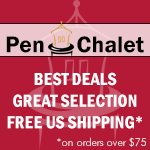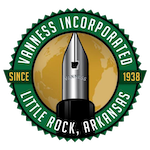(Kimberly (she/her) took the express train down the fountain pen/stationery rabbit hole and doesn't want to be rescued. She can be found on Instagram @allthehobbies because there really are many, many hobbies!.)
In many Asian cultures, especially in the Chinese culture (of which I am a part), the number 8 is an auspicious/lucky number. The number 8 in Chinese sounds similar to the word prosperity so it is quite common to see the number 8 for personalized license plates, addresses (it’s lucky to have a street address with 8, but 4 is a no-no because it sounds like death), etc. In my case, it’s been 8 years since I got my first fountain pens on May 31, 2017, so let’s take a walk down memory lane to see the early days.
I discovered fountain pens by way of Bullet Journaling so I pulled out my first BuJo to see how this turned into a pen addiction 🙂
First pens (top to bottom): Lamy Safari, Pilot Metropolitan, Platinum Preppy.
One of the spreads in my Leuchtturm 1917 A5 dot grid notebooks shows the beginning of the fall down the rabbit hole. There were many, MANY purchases in rapid succession.
My bullet journal has always been for my personal use and never something I created for social media. Clearly, I did not care about the handwriting in my bullet journal back then (or even now), lol.
This was kind of fun to look back at and see what pens I wanted.
Looking back, I would have no idea that I’d really get into certain pens (TWSBI Eco, Lamy AL-Star, cough cough), or that I’d eventually own quite a few on the list (Pilot Custom 74, VP, Platinum 3776, Visconti Van Gogh), and which ones I put in the “Dream On” column that aren’t on my radar at all, as well some that I ended up getting like the Aurora Optima Nebulosa (I realized I prefer the Optima to the 88) and Pelikan M800 Souveran. I remember adding the Visconti Homo Sapiens Bronze Age because it seemed like that was everyone’s grail pen back then (and still is for some folks), but the black with bronze trim didn’t really excite me (still doesn’t), but everyone else must know something I don’t, right? Wrong! We all like different things, so go ahead and like what you like! It’s also good/fine/normal/natural to like/love some things and having your tastes change over time. It’s a healthy part of any hobby and makes this rabbit hole all the more interesting.
One of the things that drew me into this rabbit hole was not only the cool looking fountain pens, but all the different colors of inks! I had used the Sheaffer calligraphy set when I was a kid, and it came with ink cartridges in 8 colors (blue, blue-black, and black being 3 of them). Not only were there more colors but sheen was becoming a big thing too - Akkerman Shocking Blue, Diamine Majestic Blue, Organics Studio Nitrogen, etc. just looked magical on paper!
My first pen/ink log. I maintained this throughout multiple bullet journals until a couple years ago. Also, goodness gracious, I clearly don’t care how ugly my writing is.
My ink wish list - clearly I am a blue and purple ink fan, but we already knew that. With very few exceptions, I think I own everything on this list, and then some, oops!
Bullet journaling also led me to fountain pens by way of Rock Your Handwriting, where folks posted pictures of their handwriting practice along with their pens and inks. As soon as I got my pens, I started my own journey to improve my handwriting, which used to be really nice from middle school through college, but went to crap after a long career in front of a computer.
One of many Clairefontaine French-ruled notebooks that I used to practice my handwriting daily. This was the prettiest I could make it back in June of 2017.
While I don’t use writing prompts any more, I do still practice my handwriting, still using the same Clairefontaine French-ruled notebooks, only now I’m working on Hamilton lyrics.
Eight years in and I write even more today than I did back then, whether it’s the day’s to-do list in BuJo #11, a packing list for the next pen show, transcribing Italian kids’ books, Meditations in typewriter font, journaling in my TN, or creating my next Currently Inked. I still get excited for new releases, whether they are Kaweco Sports and TWSBI (thank goodness the Precision now comes in Gemini Blue!) or other eye candy. Heck, I even love some non-fountain pens! I love using my pens and inks to learn, remember, be productive, and get thoughts on paper. I still love going to & working at pen shows, making new friends and seeing folks that have since become family. There’s always something new to learn, discover, and try, and I can’t wait to do more. It’s been a wonderful eight years, thank you for being a part of it. Eight more years (and beyond), let’s GO!!































